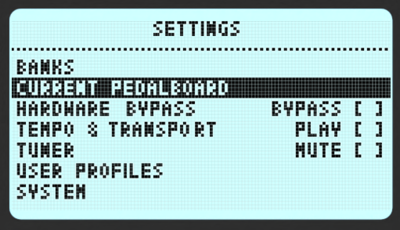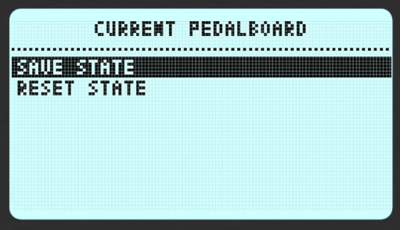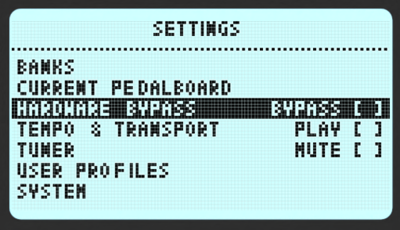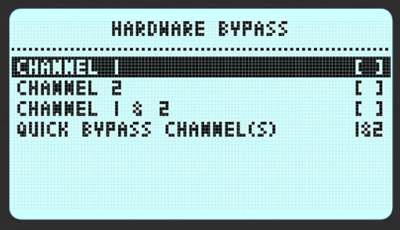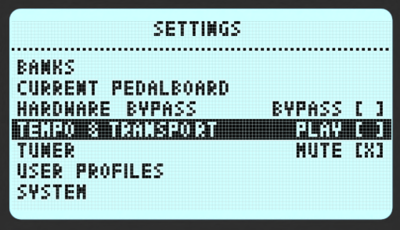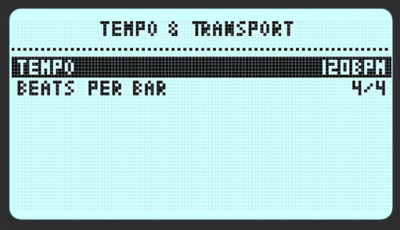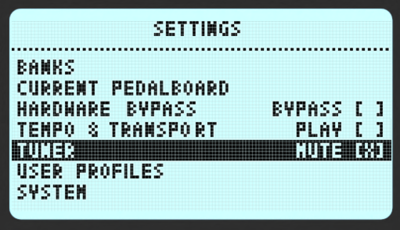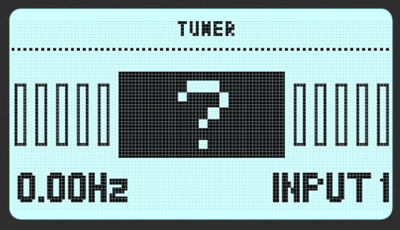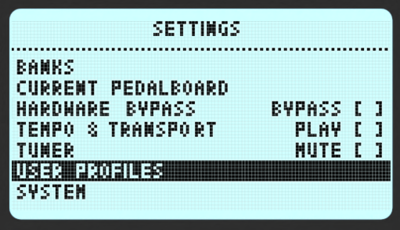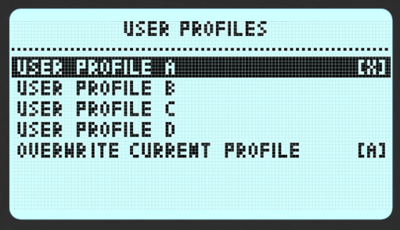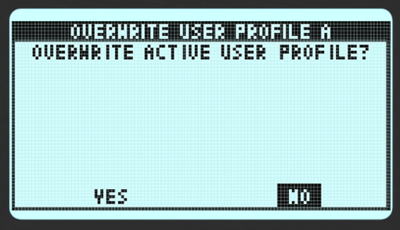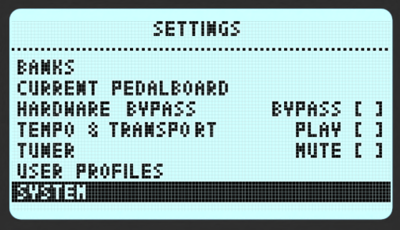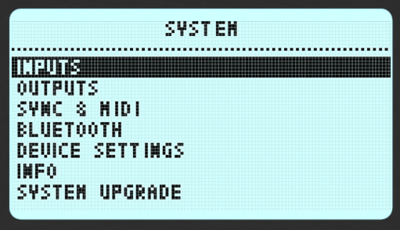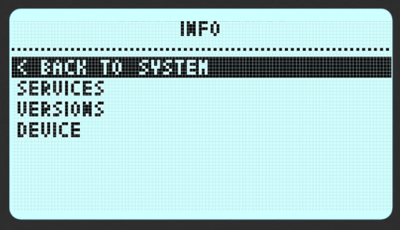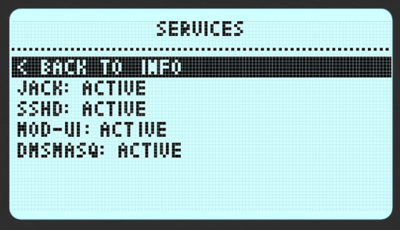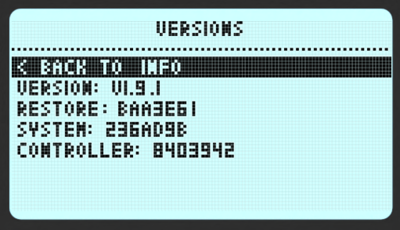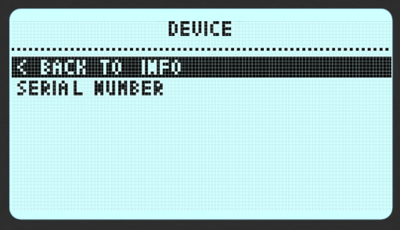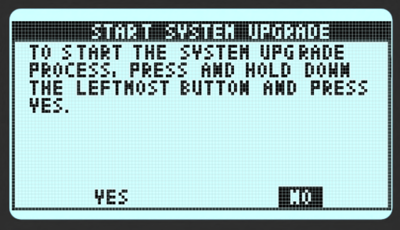Difference between revisions of "Dwarf Device Settings"
| Line 199: | Line 199: | ||
= Device Settings = | = Device Settings = | ||
| + | |||
| + | (image of device settings 2 pages on the Dwarf) | ||
<div style="display:inline-block"> | <div style="display:inline-block"> | ||
| Line 213: | Line 215: | ||
</div> | </div> | ||
| − | + | The device settings on the MOD Dwarf are divided into two pages. | |
| − | |||
| − | |||
| − | |||
| − | |||
| − | |||
| − | |||
| − | |||
| − | |||
| − | |||
| − | |||
| − | |||
| − | |||
| − | |||
| − | |||
| − | |||
| − | |||
| − | |||
| − | |||
| − | |||
| − | |||
| − | |||
| − | |||
| − | |||
| − | |||
| − | |||
| − | |||
| − | |||
| − | |||
| − | |||
| − | |||
| − | |||
| − | |||
| − | |||
| − | |||
| − | |||
| − | |||
| − | |||
| − | |||
| − | |||
| − | |||
| − | |||
| − | |||
| − | |||
| − | |||
| − | |||
| − | |||
| − | |||
| − | |||
| − | |||
| − | |||
| − | |||
| − | |||
| − | |||
| − | |||
| − | |||
| − | |||
| − | |||
| − | |||
| − | |||
| − | |||
| − | |||
| − | |||
| − | |||
| − | |||
| − | |||
| − | |||
| − | |||
| − | |||
| − | |||
| − | |||
| − | |||
| − | |||
| − | |||
| − | |||
| − | |||
| − | |||
| − | |||
| − | |||
| − | |||
| − | |||
| − | |||
| − | |||
| − | |||
| − | |||
| − | |||
| − | |||
| − | |||
| − | |||
| − | |||
| − | |||
| − | |||
| − | |||
| − | |||
| − | |||
| − | |||
| − | |||
| − | |||
| − | |||
| − | |||
| − | |||
| − | |||
| − | |||
| − | |||
| − | + | On the first page, you can make mainly visual adjustments like: | |
| − | + | * the Display Brightness | |
| − | + | * the Display Contrast | |
| − | + | * how Unassigned Actuators are represented | |
| − | |||
| − | |||
| − | |||
| − | |||
| − | |||
| − | |||
| − | |||
| − | |||
| − | |||
| − | |||
| − | |||
| − | |||
| − | |||
| − | |||
| − | |||
| − | |||
| − | |||
| − | |||
| − | + | On the second page of Device Settings, you can also set some behaviour settings for your MOD Dwarf like: | |
| + | * the Default Tool | ||
| + | * what appears on the Control Header | ||
| + | * the USB-B Mode | ||
=== Display Brightness === | === Display Brightness === | ||
| − | + | Turn the left-most endless knob to change the LCD display's brightness. The value increments in 25 steps and the available options are: | |
* 0% (off) | * 0% (off) | ||
| Line 358: | Line 242: | ||
=== Display Contrast === | === Display Contrast === | ||
| − | + | Turn the central endless knob to change the LCD displays contrast. | |
| − | + | '''Note:''' You can press the endless knob while turning to fine adjustments. | |
You should adjust this value always according to the environment and the position of the device in your setup. | You should adjust this value always according to the environment and the position of the device in your setup. | ||
=== Unassigned Actuators === | === Unassigned Actuators === | ||
| − | + | Turn the rightmost endless knob to define if the unassigned actuators should be shown or hidden on your screens. | |
These are the physical actuators that are not assigned to any parameter in your current pedalboard and also for the page that you have selected. Check more on [[Duo_X_User_Guide#Switching_pages | Switching Pages]]. | These are the physical actuators that are not assigned to any parameter in your current pedalboard and also for the page that you have selected. Check more on [[Duo_X_User_Guide#Switching_pages | Switching Pages]]. | ||
| − | === | + | === Default Tool === |
| − | + | Turn the leftmost endless knob to select your default tool. | |
| + | |||
| + | This is the tool that shows up when you simultaneously push the footswitch A and B. | ||
| + | |||
| + | You can select between: | ||
| + | * Tuner | ||
| + | * Tempo | ||
| + | |||
| + | Learn more about the available tools here (link with a chapter explaining all the available tools) | ||
| + | |||
| + | |||
| + | === Control Header === | ||
| + | |||
| + | Turn the central endless knob to select if you want your Pedalboard Name to appear on the Control Header section of the main screen of your MOD Dwarf or instead you want to have your current Snapshot Name | ||
| − | + | === USB-B Mode === | |
| − | + | Turn the leftmost endless knob to define the mode of the USB-B port on your MOD Dwarf. | |
| + | You can select between: | ||
| + | * Network (Default) | ||
| + | * Net+MIDI | ||
| + | * Net+MIDI (Windows) | ||
| − | ''' | + | '''Note: ''' to change the USB-B Mode on your MOD Dwarf it will be required to reboot the device. |
| − | + | ==== Network (Default) ==== | |
| − | + | By using this mode, your MOD Dwarf will be recognized as a network device on your host computer (or any other devices where you can access the WebGUI). | |
| − | |||
| − | + | This mode will allow you to access the WebGUI in your favourite browser by navigating to http://moddwarf.local/ (or http://192.168.51.1). | |
| − | |||
| − | + | ==== Net+MIDI ==== | |
| − | + | By using this mode, your MOD Dwarf will be recognized as a network device and also as a MIDI interface on your host computer (or any other devices where you can access the WebGUI). | |
| − | + | This mode will allow you to access the WebGUI in your favourite browser by navigating to http://moddwarf.local/ (or http://192.168.51.1). | |
| + | This mode also allows your MOD Dwarf to receive and send MIDI messages over the USB port. | ||
| − | This mode | + | '''Note:''' This mode doesn't work in some computers running Windows. |
| − | + | ==== Net+MIDI (Windows) ==== | |
| − | + | By using this mode, your MOD Dwarf will be recognized as a network device and also as a MIDI interface on your host computer (or any other devices where you can access the WebGUI). | |
| + | This mode will allow you to access the WebGUI in your favourite browser by navigating to http://moddwarf.local/ (or http://192.168.51.1). | ||
| + | This mode also allows your MOD Dwarf to receive and send MIDI messages over the USB port. | ||
| − | + | '''Note:''' This mode was specially designed to tackle the issues of having the MOD Dwarf recognized as a MIDI device on some Windows computers. | |
| − | |||
| − | |||
| − | |||
| − | |||
| − | |||
| − | |||
| − | |||
| − | |||
| − | |||
| − | |||
| − | |||
| − | |||
| − | |||
| − | |||
| − | |||
== Info == | == Info == | ||
Revision as of 15:25, 11 March 2021
This page holds the information on how to use the Settings menu on your MOD Dwarf.
Contents
Overview
These are the Settings you can access and control directly in your device, even when you are disconnected from your computer:
(Image of MOD Dwarf settings menu)
- Audio Inputs: setup your input gain values
- Audio Outputs: setup your output gain values
- Headphone Output: setup the volume of your headphones (volume of headphones output)
- Sync: setup your sync settings
- MIDI: setup your MIDI settings
- User Profiles: load and save your different user profiles settings
- Device Settings (1/2): setup the appearance of your device
- Device Settings (2/2): setup the appearance of your device, tools, and USB behavior
- Quick Items: define the Quick Items that appear when you push the Menu Button
- System Upgrade: Upgrade the operative system of your MOD Dwarf
To navigate between the items on the list of settings you should turn the left most encoder to right (going down the list) or to the left (going up on the list). To access an item menu on this list you should push the "Enter button (leftmost button pad) or you can simply push the same encoder that you use to navigate on the list. To exit this menu you should push the "Exit" button (middle button pad).
Press and hold the Menu Button on your Dwarf. This will open a screen with your defined Quick Items.
(image of Quick items menu)
While on this screen, push the left-most pad button to access your MOD Dwarf settings.
(picture of the left-most button with a circle around)
Scroll the options in the Settings menu by rotating the left-most knob. Push the same knob in order to access the selected sub-menu.
Press the central pad button to exit the Settings Menu.
(picture of the central button with a circle around)
Audio Inputs
(replace with image bellow with image of Audio inputs menu on the Dwarf)
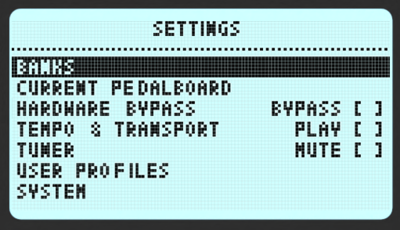
|
On this menu, you can adjust your Input Gain levels.
Turn the left-most encoder of your MOD Dwarf to adjust both of the input gains simultaneously.
Turn the central encoder of your MOD Dwarf to adjust only the input 1 gain level.
Turn the right-most encoder of your MOD Dwarf to adjust only the input 2 gain level.
Notes:
- if you push the encoder while you turn it will allow you to increase or decrease values faster;
- simply turn the knobs to fine adjust the values;
- push and turn the knobs to apply less precise adjustments.
Audio Outputs
(replace with image bellow with image of Audio inputs menu on the Dwarf)
On this menu, you can adjust the Output Gain levels of your MOD Dwarf.
Turn the left-most encoder of your MOD Dwarf to adjust both of the output gains simultaneously.
Turn the central encoder of your MOD Dwarf to adjust only the output 1 gain level.
Turn the right-most encoder of your MOD Dwarf to adjust only the output 2 gain level.
Notes: the same encoder techniques as for the input controls apply to the output settings
- if you push the encoder while you turn it will allow you to increase or decrease values faster;
- simply turn the knobs to fine adjust the values;
- push and turn the knobs to apply less precise adjustments.
Headphone Output
(replace with image bellow with image of Headphone Output menu on the Dwarf)
This menu allows you to adjust the headphone output volume on your MOD Dwarf.
Sync
(replace with image bellow with image of Sync menu on the Dwarf)
In this menu, you can select your Clock Source and define your MOD Dwarf to send a clock signal. You can set the Clock Source to be Internal, over MIDI port or Ableton Link.
MIDI
(replace with image bellow with image of MIDI menu on the Dwarf)
On this menu, you can define MIDI settings for your MOD Dwarf. This menu allows you to define the MIDI Program Change Channel used to change your pedalboards and snapshots if you define any.
User Profiles
(replace with image bellow with image of User Profiles menu on the Dwarf)
User Profiles allow you to switch between pre-configured device settings.
Say you use your device sometimes to play with your guitar and microphone, in the studio, and sometimes with a synth in a live performance. For each situation, you might need to have different Input and Output gains and volume settings. So a user profile can be used to quickly switch between setups.
The settings that can be stored in a User Profile are:
- Input settings: Everything under System > Inputs
- Output settings: Everything under System > Outputs
- Sync and MIDI settings: Everything under System > Sync and MIDI
Switching between User Profiles
To switch between users profile you simply need to turn the left most endless knob. This will allow you to swipe between all the user profiles. To validate the selection you should click the knob while the new User Profile shows us up to you.
(image showing this)
Saving a new User Profile
You can have up to four User Profiles. The first step to save a new user profile is to choose which from these four profiles will be overwritten. You do that by turning the central endless knob.
Before saving you must:
- Navigate to System Settings and change values for Input, Output, and Sync an MIDI settings
- Navigate back to the User Profiles menu
After selecting the profile that you want to change, click the central endless knob to confirm it.
Device Settings
(image of device settings 2 pages on the Dwarf)
The device settings on the MOD Dwarf are divided into two pages.
On the first page, you can make mainly visual adjustments like:
- the Display Brightness
- the Display Contrast
- how Unassigned Actuators are represented
On the second page of Device Settings, you can also set some behaviour settings for your MOD Dwarf like:
- the Default Tool
- what appears on the Control Header
- the USB-B Mode
Display Brightness
Turn the left-most endless knob to change the LCD display's brightness. The value increments in 25 steps and the available options are:
- 0% (off)
- 25%
- 50%
- 75%
- 100%
You should adjust this value accordingly to your environment and to your viewing angle. Flat viewing angles may require higher brightness settings and vice versa.
Display Contrast
Turn the central endless knob to change the LCD displays contrast.
Note: You can press the endless knob while turning to fine adjustments.
You should adjust this value always according to the environment and the position of the device in your setup.
Unassigned Actuators
Turn the rightmost endless knob to define if the unassigned actuators should be shown or hidden on your screens.
These are the physical actuators that are not assigned to any parameter in your current pedalboard and also for the page that you have selected. Check more on Switching Pages.
Default Tool
Turn the leftmost endless knob to select your default tool.
This is the tool that shows up when you simultaneously push the footswitch A and B.
You can select between:
- Tuner
- Tempo
Learn more about the available tools here (link with a chapter explaining all the available tools)
Control Header
Turn the central endless knob to select if you want your Pedalboard Name to appear on the Control Header section of the main screen of your MOD Dwarf or instead you want to have your current Snapshot Name
USB-B Mode
Turn the leftmost endless knob to define the mode of the USB-B port on your MOD Dwarf. You can select between:
- Network (Default)
- Net+MIDI
- Net+MIDI (Windows)
Note: to change the USB-B Mode on your MOD Dwarf it will be required to reboot the device.
Network (Default)
By using this mode, your MOD Dwarf will be recognized as a network device on your host computer (or any other devices where you can access the WebGUI).
This mode will allow you to access the WebGUI in your favourite browser by navigating to http://moddwarf.local/ (or http://192.168.51.1).
Net+MIDI
By using this mode, your MOD Dwarf will be recognized as a network device and also as a MIDI interface on your host computer (or any other devices where you can access the WebGUI).
This mode will allow you to access the WebGUI in your favourite browser by navigating to http://moddwarf.local/ (or http://192.168.51.1). This mode also allows your MOD Dwarf to receive and send MIDI messages over the USB port.
Note: This mode doesn't work in some computers running Windows.
Net+MIDI (Windows)
By using this mode, your MOD Dwarf will be recognized as a network device and also as a MIDI interface on your host computer (or any other devices where you can access the WebGUI).
This mode will allow you to access the WebGUI in your favourite browser by navigating to http://moddwarf.local/ (or http://192.168.51.1). This mode also allows your MOD Dwarf to receive and send MIDI messages over the USB port.
Note: This mode was specially designed to tackle the issues of having the MOD Dwarf recognized as a MIDI device on some Windows computers.
Info
This section displays several information about your device:
Services: The status of the different services running
Versions: Version of MOD software
Device: The serial number of your device
Note: You can also access this information in the Web GUI Settings page
System Upgrade
This option is only meant to be used for maintenance purposes. In a regular situation, all software upgrades will be performed via the Web GUI interface.
If you need to run a manual upgrade, use this option. See Manual upgrade for more details.
